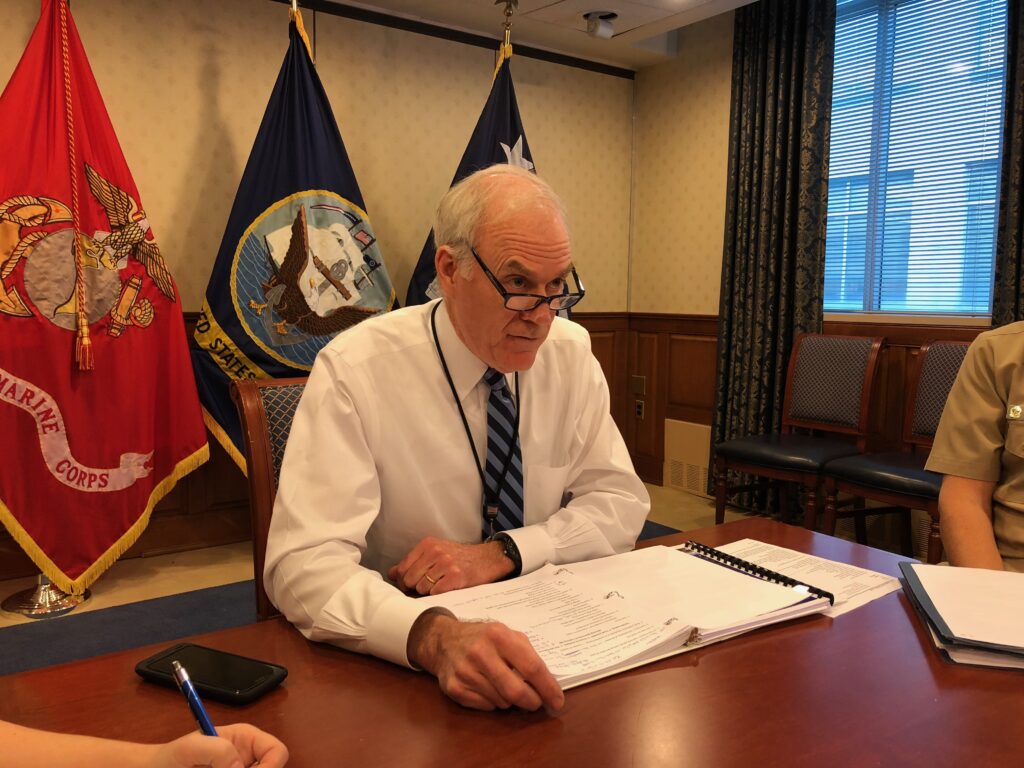House Approps Chair Promises Pentagon ‘Flexibility’ On O&M Funds
Posted on

Operations & Maintenance (O&M) accounts pay for military training like this exercise at the Joint Readiness Training Center, Fort Polk, La.
CAPITOL HILL: Legislators will probably loosen some rules on federal spending to help the Pentagon cope with Congress’s failure to pass funding bills until six months into the fiscal year.

Rep. Rodney Frelinghuysen
House appropriations chairman Rodney Frelinghuysen promised Navy leaders this morning that “we’ve worked out a path forward to provide that degree of flexibility you and the other services are looking for.” Sources familiar with the Senate side predicted Senate appropriators would offer leeway as well.
Frelinghuysen didn’t offer details. When I pressed him after the hearing, the chairman said only that he hoped to allow the maximum flexibility consistent with the appropriators’ oversight responsibilities — which the committee is in deadly earnest about.
We do know, at least, what the Defense Department is asking for. Navy Secretary Richard Spencer told reporters after the hearing that the Pentagon comptroller has asked for relief on “three points”:
- loosening the 80:20 rule, which forbids federal agencies from spending more than 20 percent of their funding in the last two months of the fiscal year;
- raising the maximum amount allowed for a Below Threshold Reprogramming (BTR), in which the Pentagon reallocates funding without having to get prior approval from Congress;
- allowing at least some funds that would normally expire at the end of the fiscal year, September 30th, to “roll over” into fiscal 2019.
“We’ll take what we can get,” Spencer said.
“We’ve been in a pretty solid dialogue with the committees about this,” added the Chief of Naval Operations, Adm. John Richardson, “and they’ve been terrific.”
What kind of latitude will appropriators ultimately offer? One knowledgeable ex-Senate staffer predicted more reprogramming authority and three months leeway to spend 2018 money in fiscal 2019.
This Morning’s Hearing
The exchange between Frelinghuysen and Spencer at the hearing is worth reading in some detail.
“Once we get our bill passed for 2018 you’re going to have a lot of money to deal with,” Frelinghuysen said. “How are you going to spend it in the time that you have between now and October first?”

Navy Secretary Richard Spencer talks to sailors aboard the Littoral Combat Ship USS Giffords
“We are putting the tools in place to monitor how we’re going to put the resources out,” Spencer replied. “In my weekly meetings with FMC (Financial Management/Comptroller), we are monitoring what we’re doing now on the CR curve and we will step up into 18 when the bill is approved, ready to step to ’19.”
The Navy secretary added, “We would ask — and I totally understand the role of the appropriations committee and I understand the control which is warranted — I would ask if we could find any relief….”
“We are addressing the whole issue of flexibility,” Frelinghuysen interrupted.
“We greatly appreciate it, sir,” said Spencer.
“Obviously the committee has its interests and jurisdiction,” Frelinghuysen said. “Oversight is important. (This defense subcommittee) I know under Ms. Granger’s chairmanship wants to make sure that all those dollars are spent responsibly. So I think we’ve worked out a path forward to provide that degree of flexibility you and the other services are looking for.”
“Outstanding. We welcome that with open arms,” Spencer said. “We have programs racked and stacked. We have our contracting people already gearing up, because it is going to be a task. We will come before you when in fact we see some difficulties.”

Robert Hale
How We Got Here
While some appropriations remain available for two or more years after they’ve been enacted, a big chunk of the Pentagon budget is so-called one-year money that must be put on contract (obligated) in the fiscal year it’s appropriated for. That includes pay and benefits for military personnel (MILPERS) and much-needed readiness funds, formally known as Operations & Maintenance (O&M).

SOURCE: Fiscal Law Deskbook, 2014
One year would normally be enough, but the budget process hasn’t been normal for a decade. Nine fiscal years in a row have started without a proper spending bill. While spending can continue on autopilot at the prior-year levels under what’s called a Continuing Resolution (CR), any changes — adjustments to existing programs, program cancellations, and new starts — have to wait until an appropriations bill is passed.
Though the recent budget deal keeps the government open, the 2018 appropriations bill won’t pass until March 23rd, almost halfway through the fiscal year. Once it passes, federal agencies will have to rush to spend any additional one-year money before it expires on Oct. 1. For the many programs getting budget increases, the challenge will be efficiently spending whatever the extra amount is about the CR level. For new-start programs, however, where the CR level is zero, they’ll have to spend all their one-year money in the next six months.
Playing catch-up this way with millions of taxpayer dollars is a recipe for haste, inefficiency and waste. Ideally, Congress would start passing appropriations on time, but after nine years of CRs, that solution seems unlikely.
“I strongly believe DoD needs some more flexibility in budget execution, not just in FY18 but in all years,” said Bob Hale, Pentagon comptroller for five years under Obama and now a senior advisor at consulting firm Booz Allen Hamilton. “I agree with all three of these proposals (from the administration) but I have priorities among them.”
- “Carryover would be my highest priority. DoD needs some ability to carry over funds in the O&M and military personnel accounts. It doesn’t make sense to insist on obligating all these funds in the year appropriated. That is particularly problematic in FY18, with the late appropriation. But in every year the absence of carryover authority leads to the year-end spending spree….I would favor carryover of 5% in each O&M and MILPERS appropriation. But I would take what I could get!”
- “Higher BTR (reprogramming) thresholds would also help,” Hale said. Under current law DoD needs prior congressional approval to move more than $10 million in a given military personnel account, and to move more than $15 million in an O&M account — a drop in the bucket when those accounts “are often in the tens of billions.”
- “For FY18, with the late appropriation, waiving the 80/20 rule would make sense too,” he added.
“How receptive have appropriators been to ideas like this? Very unreceptive,” Hale said. “For example, in 2013 I tried to get carryover authority of five percent for O&M and MILPERS. One chamber approved 1 percent, the other would not even go with that. So nothing happened.”
But that is beginning to change.

Navy Secretary Richard Spencer discusses his Strategic Readiness Review with reporters.
Growing Support
Last year, after accidents that killed 17 sailors, Navy Secretary Spencer’s independent Strategic Readiness Review proposed extending the time readiness money is available. Instead of “use it or lose it” in the fiscal year for which it’s appropriated, the SRR said, let the Navy spend Operations & Maintenance either for a full year after the date the appropriations bill is enacted — which would automatically compensate for delays on the Hill– or for a year after the year of enactment.
In mid-February, Army Secretary Mark Esper told reporters he’d been asking members of Congress to make Operations & Maintenance two-year money, while House defense appropriations chair Kay Granger told our colleagues at Defense News she wanted to fix the “artificial deadline” of Sept. 30.

Sen. Roger Wicker
Last Monday, Senate seapower chairman Roger Wicker proposed a bill to make O&M for the Navy (only) two-year money. (See our exclusive interview here).
Yesterday, at the McAleese/Credit Suisse defense conference here in Washington, several legislators and officials expressed support for some flexibility. Particularly popular was the idea of giving the Pentagon an extra day to spend the money for each day Congress was late in appropriating it. Essentially, that’s the same “a year from the date of appropriation” rule proposed by the Navy’s SSR. We heard this idea from both Rep. Rob Wittman, the House seapower chairman and former readiness subcommittee chairman, and Lt. Gen. John Murray, the Army’s deputy chief of staff for resources (G-8). (Murray emphasized he was expressing his own thoughts and not Army policy, although his statement certainly lines up with Secretary Esper’s).
Air Force Secretary Heather Wilson was less specific but generally supportive. “Give us the flexibility we need to execute smartly,” she said, “because you don’t want a contracting officer signing the contract because he’s got to meet some deadline (on) the 30th of September.”
Meanwhile, House airland subcommittee chairman Mike Turner has introduced the “It’s About Time Act” that would “solve” the problem by pushing the start of the fiscal year back four months, from October 1st to January 1st. The idea produced a snort of laughter from at least one audience member near me when Turner proposed it at McAleese. Like getting your credit card company to change your monthly due date, this seems like the kind of short-term fix that would help, at most, once.
Subscribe to our newsletter
Promotions, new products and sales. Directly to your inbox.
